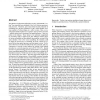Free Online Productivity Tools
i2Speak
i2Symbol
i2OCR
iTex2Img
iWeb2Print
iWeb2Shot
i2Type
iPdf2Split
iPdf2Merge
i2Bopomofo
i2Arabic
i2Style
i2Image
i2PDF
iLatex2Rtf
Sci2ools
102
click to vote
APGV
2005
ACM
2005
ACM
Scene consistency and spatial presence increase the sensation of self-motion in virtual reality
The illusion of self-motion induced by moving visual stimuli (“vection”) has typically been attributed to low-level, bottom-up perceptual processes. Therefore, past research has focused primarily on examining how physical parameters of the visual stimulus (contrast, number of vertical edges etc.) affect vection. Here, we investigated whether higher-level cognitive and top-down processes – namely global scene consistency and spatial presence – also contribute to the illusion. These factors were indirectly manipulated by presenting either a natural scene (the Tübingen market place) or various scrambled and thus globally inconsistent versions of the same stimulus. Due to the scene scrambling, the stimulus could no longer be perceived as a consistent 3D scene, which was expected to decrease spatial presence and thus impair vection. Twelve naive observers were asked to indicate the onset, intensity, and convincingness of circular vection induced by rotating visual stimuli presente...
| Added | 26 Jun 2010 |
| Updated | 26 Jun 2010 |
| Type | Conference |
| Year | 2005 |
| Where | APGV |
| Authors | Bernhard E. Riecke, Jörg Schulte-Pelkum, Marios N. Avraamides, Markus Von Der Heyde, Heinrich H. Bülthoff |
Comments (0)

